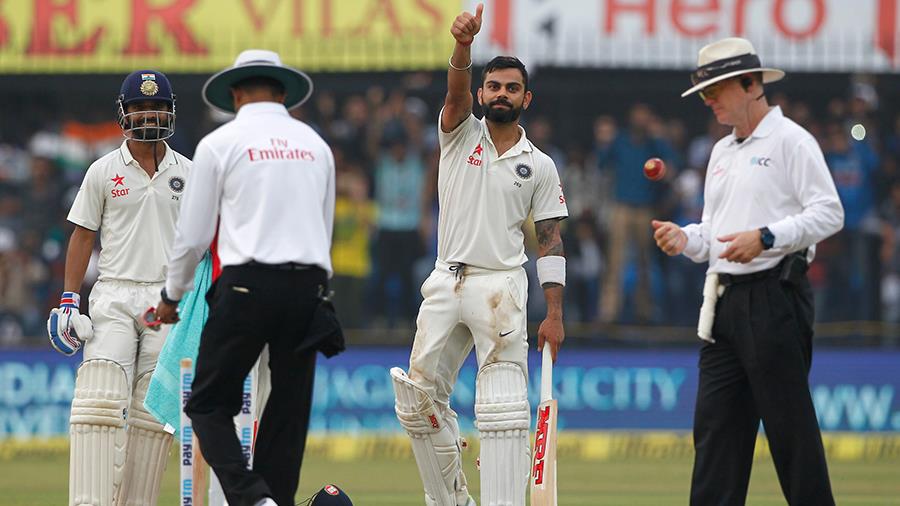October 8, 2016
Brief Scorecard: India 267 for 3 (Kohli 103*, Rahane 79*, Pujara 41, Gambhir 29) v New Zealand

Virat Kohli gestures to the dressing room after scoring his century, India v New Zealand, 3rd Test, Indore, 1st day, October 8, 2016 – BCCI
October 8, 2016
Brief Scorecard: India 267 for 3 (Kohli 103*, Rahane 79*, Pujara 41, Gambhir 29) v New Zealand

Virat Kohli gestures to the dressing room after scoring his century, India v New Zealand, 3rd Test, Indore, 1st day, October 8, 2016 – BCCI
INDORE: Virat Kohli treated the 20,000-odd people who turned up for Indore’s Test debut with a century (103*) that, along with Ajinkya Rahane’s unbeaten 79, gave India the upper hand on a largely old-fashioned, attritional day of Test cricket.
The duo joined hands when India were in a tricky position at 100 for 3, and took their side to 267 for 3 with an unbroken 167-run partnership at stumps on the first day of the third Test on Saturday (October 8). Their strike rates – Kohli scoring at around 53 and Rahane’s hovering around 45 – says a lot about how hard they had to work for their runs.
Kohli’s 13th century – his first at home in more than three years – came after a string of modest scores, but what would please him most is the circumstances under which the runs came. It wasn’t a typical Kohli ton filled with all-round strokeplay, but one of toil in fairly tough conditions against a disciplined attack.
Ditto for Rahane, who yet again made tough and invaluable runs without much fuss.
It was another day of toil for New Zealand’s bowlers – they had India in trouble in the first half of the day, but again couldn’t drive home the advantage. From the Indian perspective, though, it was another occasion in the series where they seized key moments through different personnel.
Kane Williamson wore a wry smile after his first call on returning to the side went against him. Kohli had just won his seventh straight toss at home, and obviously opted to bat first. Both captains knew the importance of the toss, especially on a dry pitch that is likely to get increasingly tough for batting.
On such tracks, the best time to score runs is against the hard, new ball. The Indian openers understood that and raced away, M Vijay playing two typically delightful cover-drives and Gautam Gambhir hooking Matt Henry for consecutive sixes.
India plundered 26 runs in the first four overs but Williamson’s second crucial call – to introduce spin – coupled with freaky catching ended the promising partnership. Vijay played a neat flick off Jeetan Patel, only to see Tom Latham hold onto a sharp catch at forward short-leg.
Gambhir was returning to the side after more than two years but took the challenge head-on. With an open-chested stance to prevent poking outside off, he cut and pulled confidently, scoring his first 24 runs only in boundaries. However, once the spinners came on and run-scoring became difficult, Gambhir went into his shell before being trapped leg before by Trent Boult. Gambhir’s first 24 runs came in just 20 balls, but his next five took 33.
Cheteshwar Pujara began in typically solid fashion and took India to lunch along with Kohli, but succumbed to pressure created by disciplined bowling after the interval. Patel in particular produced a tough spell and tested Pujara’s footwork, keeping him tied to the crease with accurate lengths.
It was, however, Mitchell Santner, who reaped the rewards of Patel’s hard work. The left-arm spinner went past Pujara’s unsure defence with a beauty that just turned enough to uproot off-stump. At 100 for 3 on a tricky track, India were on the edge.
But unlike Pujara, Kohli’s footwork looked much more assured and decisive. Building on the confidence from his crucial 45 in the second innings of the Kolkata Test, he either went fully forward or deep in the crease to negotiate the turn and bounce. It enabled him to keep his drives along the ground and also gave him time to place his pulls and flicks with precision.
It helped that he had equally solid company in Rahane. There were some moments of alarm, especially when Rahane top-edged Boult to deep square-leg, but Henry misjudged a tough catch. The awkward bounce when the ball was banged in short also troubled Rahane – he was twice ‘caught’ behind when the ball lobbed off the elbow guard.
The usually fluent Rahane took 41 balls to score his first boundary but looked as compact as ever even during the toughest of phases. In the process, he also completed a little milestone, going past 2000 Test runs as India went into tea at 148 for 3.
The post-tea session was all about India building on the good work and going from strength to strength. Henry and Jimmy Neesham got a bit of reverse swing, but once the partnership and Kohli went past the half-century mark, the scoring rate saw a gradual increase.
Kohli’s drives and flicks had more punch, while Rahane too began to open up amid all those defensive dead-bats. He unsettled Patel with a lofted shot over mid-off and later stepped out to whack the offspinner over deep mid-wicket to bring up his half-century. Even the second new ball only resulted in the ball travelling to the boundaries quicker.
Kohli had a nervous moment came when a direct hit from point threatened to end his stay on 99, but he had just about made it to safety for a well-deserved century.
At the end of it all, the captain and vice-captain were still in the middle, ensuring that an even bigger audience would turn up at the ground on Sunday.
Courtesy: Wisden India

















































































































